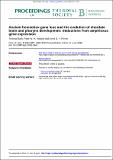Files in this item
Ancient homeobox gene loss and the evolution of chordate brain and pharynx development : deductions from amphioxus gene expression
Item metadata
| dc.contributor.author | Butts, Thomas | |
| dc.contributor.author | Holland, Peter W.H. | |
| dc.contributor.author | Ferrier, David Ellard Keith | |
| dc.date.accessioned | 2012-03-27T23:40:11Z | |
| dc.date.available | 2012-03-27T23:40:11Z | |
| dc.date.issued | 2010-11-22 | |
| dc.identifier | 4103492 | |
| dc.identifier | 8fcb5719-9ac7-43e0-a52b-9860b79b40db | |
| dc.identifier | 78149256223 | |
| dc.identifier.citation | Butts , T , Holland , P W H & Ferrier , D E K 2010 , ' Ancient homeobox gene loss and the evolution of chordate brain and pharynx development : deductions from amphioxus gene expression ' , Proceedings of the Royal Society B: Biological Sciences , vol. 277 , no. 1699 , pp. 3381-3389 . https://doi.org/10.1098/rspb.2010.0647 | en |
| dc.identifier.issn | 0962-8452 | |
| dc.identifier.other | ORCID: /0000-0003-3247-6233/work/36423833 | |
| dc.identifier.uri | https://hdl.handle.net/10023/2473 | |
| dc.description.abstract | Homeobox genes encode a large superclass of transcription factors with widespread roles in animal development. Within chordates there are over 100 homeobox genes in the invertebrate cephalochordate amphioxus and over 200 in humans. Set against this general trend of increasing gene number in vertebrate evolution, some ancient homeobox genes that were present in the last common ancestor of chordates have been lost from vertebrates. Here, we describe the embryonic expression of four amphioxus descendants of these genes—AmphiNedxa, AmphiNedxb, AmphiMsxlx and AmphiNKx7. All four genes are expressed with a striking asymmetry about the left–right axis in the pharyngeal region of neurula embryos, mirroring the pronounced asymmetry of amphioxus embryogenesis. AmphiMsxlx and AmphiNKx7 are also transiently expressed in an anterior neural tube region destined to become the cerebral vesicle. These findings suggest significant rewiring of developmental gene regulatory networks occurred during chordate evolution, coincident with homeobox gene loss. We propose that loss of otherwise widely conserved genes is possible when these genes function in a confined role in development that is subsequently lost or significantly modified during evolution. In the case of these homeobox genes, we propose that this has occurred in relation to the evolution of the chordate pharynx and brain. | |
| dc.format.extent | 895347 | |
| dc.language.iso | eng | |
| dc.relation.ispartof | Proceedings of the Royal Society B: Biological Sciences | en |
| dc.subject | QL Zoology | en |
| dc.subject.lcc | QL | en |
| dc.title | Ancient homeobox gene loss and the evolution of chordate brain and pharynx development : deductions from amphioxus gene expression | en |
| dc.type | Journal article | en |
| dc.contributor.sponsor | BBSRC | en |
| dc.contributor.institution | University of St Andrews. School of Biology | en |
| dc.contributor.institution | University of St Andrews. Scottish Oceans Institute | en |
| dc.contributor.institution | University of St Andrews. Marine Alliance for Science & Technology Scotland | en |
| dc.identifier.doi | 10.1098/rspb.2010.0647 | |
| dc.description.status | Peer reviewed | en |
| dc.identifier.grantnumber | BBS/B/12067 | en |
This item appears in the following Collection(s)
Items in the St Andrews Research Repository are protected by copyright, with all rights reserved, unless otherwise indicated.

